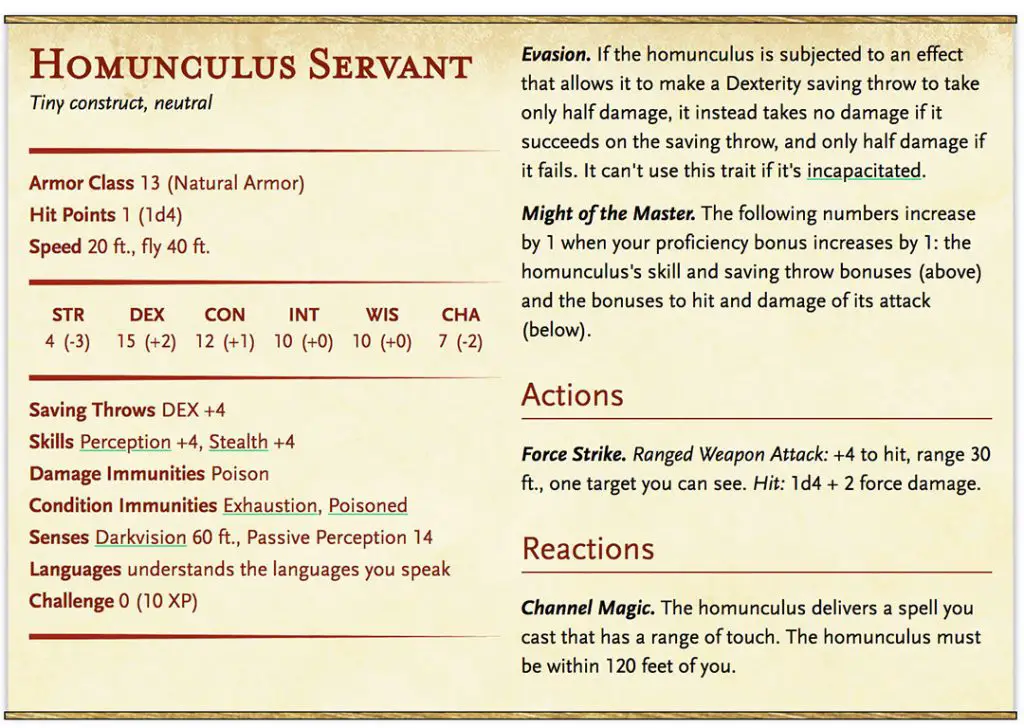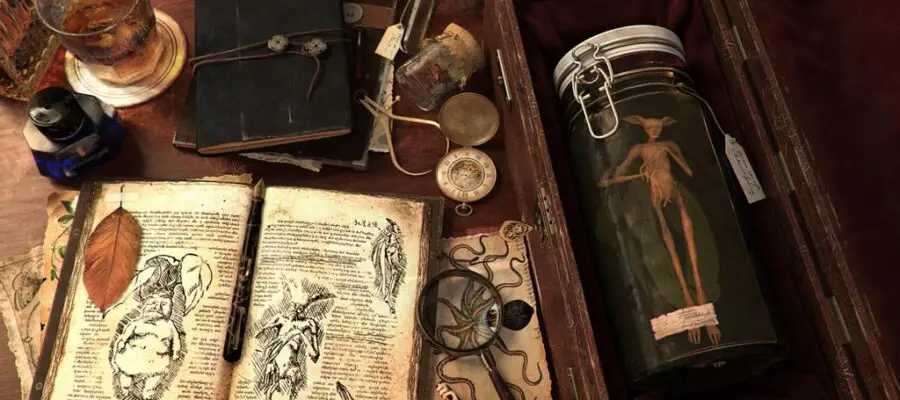“Specimen Unknown” by uoa7, CC Attribution-Noncommercial-No Derivative Works 3.0 License
Disclaimer: This article contains affiliate links that add gold to our coffers.
Note: This article was previously written for the Unearthed Arcana edition of the Artificer and was updated on January 1, 2020, to reflect the addition of the class to the Wizards of the Coast book, Eberron: Rising from the Last War (pg. 54-63) (Affiliate link that contributes a little bit to our coffers).
Also, we’ve released our Artificer’s Field Guide, a compilation of nearly 500 plant and animal components, including magical effects, terrains, collection information, and more! Plus, it’s free! Download the guide today.
If you’re already well-versed in the Artificer class, check out our related article about Artificer Battle Tactics.
We’re obsessing over the newest Dungeons and Dragons class, the Artificer. Combining alchemy, tinkering, magic item crafting, and spellcasting, this class is full of imaginative possibilities. Stay tuned for the level 20 ability, which is by far our favorite of any class.
“Nothing excites an artificer quite like uncovering a new metal or discovering a source of elemental energy. In artificer circles, new inventions and strange discoveries create the most excitement.“
What is an Artificer?
An artificer is the technical name for a skilled craftsman or inventor. In Dungeons and Dragons, an artificer combines love for tinkering with other skills like alchemy, herbalism, smithing, woodcrafting, and spellcasting.
What do we love about the Artificer?
In short, the many tool proficiencies, their ability to craft magic items faster, the feature to replicate magic items via Infusions, and their ability to attune to up to 6 items AND gain +1 bonus to all saving throws per attunement (at level 20).
What skills does an Artificer focus on?
The Artificer build is initially similar to a Rogue, but with a few differences: 1d8 hit dice, light/medium armor and shield proficiencies, simple weapons, thieves tools along with tinker tools and an artisan’s tool of choice (bonus, an Artificer will gain the ability to create artisan tools within an hour at level 3). Decide your subclass beforehand to gain additional tool proficiencies.
An Artificer focuses on Intelligence with proficiency in this saving throw. She also gains the Constitution saving throw. Skills may include two from this list: Arcana, History, Investigation, Medicine, Nature, Perception, and Sleight of Hand. There is also an option for Firearm Proficiency.
Intelligence and Constitution: From this, we can picture a character who is smart and curious, but maybe accidentally blows himself up sometimes while tinkering with a new invention. He must be mentally sharp and have a strong will. His spellcasting DC and modifier will be based on Intelligence, as well, so make this your priority stat.
Maybe he doesn’t get in the thick of battle and would rather keep his distance, but he knows how to set up a trap or a contraption that would enable him and his party to have an advantage over his foes.
Or, perhaps he is brave and throws his magic-infused sword around like a champion, operating unexpected inventions with nasty effects.
How does the Artificer use magic?
Magical Tinkering
Beginning at level 1, an Artificer learns how to sprinkle magic into mundane objects. At first, the Artificer learns how to cause an object to shed light, emit a recorded message or nonverbal sounds, or display a static visual effect. These effects can last indefinitely.
Spellcasting through Inventions
The Artificer has a varied list of spells available, including some spells from Xanathar’s Guide to Everything.
One cool distinction: “You produce your artificer spell effects through your tools.” Your artisan or thieves tools becomes your spellcasting focus. With a list of prepared spells, an Artificer proverbially “uses an invention” to produce a spell effect.
For instance, to cast “Cure Wounds,” an Artificer can mash together a healing balm with an Herbalism Kit, or pull out a mechanism that she created with her tinker tools that quickly stitches together a cut. To produce “Heat Metal” effects, maybe the Artificer whips out a wrist rocket that emits electromagnetic waves that heat a metal surface. All effects will follow the spell description, but the flavor and methods are up to the player. Furthermore, justification for how these spell effects are created isn’t necessary. Saying you have a gadget that does a spell effect you are allowed to do is sufficient enough.
Keep in mind that you can swap out cantrips each time your Artificer levels up, and you prepare your spell list each long rest.
Fast Pass to Magic Items
Another way the Artificer uses magic is by infusing magic into non-magical objects. Normally, creating a magic item would require money and time or a great quest to find components. See our explanation in this article, Crafting Magic Items.
However, as an Artificer, you can bypass these requirements through the Infuse Item feature. There is a list of specific infusions an Artificer can produce in an item, with a limited quantity of infusions known per level, but he can switch these out whenever he gains a level in that class. An Artificer can also only infuse a limited number of items before the oldest infusions putter out.
These infusions include: teleportation boots; enhanced arcane focus, armor, and weapons; a homunculus servant; a radiant weapon; an improvement on ranged weapons; and replications of a myriad of magical items.
Fear not that an Artificer can only have a limited number of infusions, for if you wish to craft a magic item with a rarity of common or uncommon from level 10 onward, it takes you a quarter of the time and costs half as much as normal!
Replicable Magic Items
One of the coolest features of the Artificer are the replicable magic items infusions available to this class. As a 2nd level Artificer, you could replicate a bag of holding and a wand of secrets at no cost to you. If your wand has served its purpose, swap it out for an alchemy jug. You can also choose among the Common Magic Items (pg. 136) in Xanathar’s Guide to Everything.
Plus, at level 10, you can attune to 4 magic items, at level 14, you can attune to 5, and at level 18, you can attune to 6! So using your infusions, at level 10, you can infuse 4 items, such as Bracers of Archery, Helm of Telepathy, Winged Boots, and Ring of Mind Shielding.
Note: In the Unearthed Arcana version, the Artificer class gains a new spells: Arcane Weapon (1st-level transmutation), where the caster channels magical energy of one of six types (acid, cold, fire, lightning, poison, or thunder) through his simple or martial weapon and deals an extra 1d6 of this damage, causing the weapon type to become magical. Ask your Dungeon Master about allowing this spell as an Artificer.
Spell Storing
By level 11, an Artificer can store a 1st or 2nd level (one action to cast) spell in a martial/simple weapon or an item and use an action to unleash the spell. The spell is stored in the item for uses equal to twice the Artificer’s intelligent modifier.
Note that the rules state “a creature can take an action to produce the spell’s effect from it, using your spellcasting ability modifier.” This means that you can store an Artificer spell in an item and have your ally use the spell at a later time, and it need not be a spell you have prepared.
However, beware that you can only store one spell in one item at a time.
What can an Artificer specialize in?
A player can choose between these four archetypes: Alchemist, Artillerist, or Battle Smith. Each subclass gains tool proficiencies and spells unique to the type.
Note: Unearthed Arcana edition also had an Archivist subclass, which we will include in this writeup.
Alchemist
An expert at combining exotic reagents to produce magical effects.
This subclass focuses on healing, potions, and elixirs, and an Alchemist will gain proficiencies with alchemist supplies.
Beginning at 3rd level, an Alchemist can magically conjure an experimental elixir, a random potion that fills an empty flask. The potion effects include healing, swiftness, resilience, boldness, flight, and transformation.
At level 5, an Alchemist has additional healing abilities, and at level 9, she can incorporate restorative reagents into some of her works, such as casting lesser restoration without expending a spell slot.
At level 15, an Alchemist becomes resistant to acid and poison damage and immune to the poisoned condition. She can also cast Greater Restoration without expending a spell slot once per long rest.
One Infusion that may be particularly interesting to an Alchemist is the tiny construct Homunculus Servant. Additional to battle abilities, a Homunculus Servant may deliver a spell you cast that has a range of touch. The description of the Homunculus includes that the construct “obeys your commands.”

Though a tiny creature is limited to 2.5 ft x 2.5 ft (about .76 meters x .76 meters) according to the Player’s Handbook (pg. 191), a Homunculus has a Strength of 4, which means its carrying capacity is 45 lbs or about 20 kg (4 x 15 lbs, PHB pg. 176). Thus, your construct could assist in harvesting potion components, gathering materials for Magic Item formulas, and much more!
For a spooky twist on this ability, see our article on how to play an Alchemist Necromancer.
Archivist (Unearthed Arcana Edition)
An expert at artificial intelligence and storing information.
This subclass focuses on knowledge and methods to store vast amounts of information. An Archivist will gain proficiencies in calligrapher’s supplies and the forger’s kit and will gain those supplies for free (though gaining supplies freely was nixed in the Eberron book for the other subclasses). Scrolls take a quarter of the amount of time to craft and half the amount of gold (this was also nixed in Eberron with the other archetypes).
An Archivist gains additional spells and can create an Artificial Mind. The Artificial Mind supplies the Archivist with knowledge about certain topics telepathically. From a table in the UA, the Archivist will gain two skills based on its Artificial Mind’s main material, such as Animal Handling from an Artificial Mind made from a piece of bone, or the Arcana skill from a piece of wood.
As a bonus action, the Mind can hover as a spectral presence up to 300 feet from its physical self. It can hear, see, and has darkvision of 60 feet. As an action, she can hear and see what it does, so long as she is concentrating on it. An Archivist can also cast a spell as if she were in the spectral Mind’s space, using its senses, up to a number of times equal to the Archivist’s Intelligence modifier.
An Archivist can also overload a target with information, causing psychic damage. This can be done from the Archivist or from the Spectral Artificial Mind.
At 6th level, an Archivist can telepathically communicate two-ways with someone holding one of his Infused items.
By level 14, an Archivist can digitally teleport to a space near the Spectral Artificial Mind.
Artillerist
An expert in creating magical explosions, defensive positions, and magic-infused sidearms.
The Artillerist will gain proficiencies in Woodcarver’s Tools and can magically create a magical cannon at level 3 using his Woodcarver’s Tools (or Smithing Tools). This small or tiny cannon either occupies a 5 x 5 ft space or can be held in one’s hands, respectively.
As a magical object, this cannon has an AC of 18 and hit points equal to five times your Artificer level. Immune to poison, psychic damage, and all conditions, its ability scores for saving throws is 10. It can regain hit points via the mending spell and may have legs.
There are three types of cannons one can create: Flamethrower, Force Ballista, or Protector. Cannons gain additional power and fortification at levels 9 and 15. Eventually, you’ll be able to conjure a second cannon (level 15).
At level 5, wands, staffs, and rods can become an Artificer’s arcane focus, and Artificer spells cast through the firearm gain a 1d8 bonus to one of the spell’s damage rolls.
Battle Smith
An expert protector and combat medic.
Battle Smiths are the perfect combination of creator and battle master. A Battle Smith becomes proficient with Smith’s Tools. She will also gain proficiency with martial weapons and can use Intelligence as her attack modifier when using magical weapons.
A Battle Smith can also create an Iron Defender, which has its own stats block and actions: Force-Empowered Rend, Repair, and Deflect Attack reaction. It can also take the dodge, dash, disengage, and help actions. Unless otherwise commanded as a bonus action, the Iron Defender will take the dodge action every turn.
At 5th level, the Battle Smith gains an extra attack, and at 9th level, an Arcane Jolt feature, which either heals or harms.
What is the Artificer’s level 20 ability?
We’re often disappointed with level 20 abilities. Some are highly underwhelming, such as the Ranger, which gives way to an easy choice to multiclass. However, with the Artificer, you do NOT want to miss his level 20 feature: Soul of Artifice.
First, the Artificer mingles his soul with magic items linked to him. This spooky, delicious lore should get you excited for his ability. Recall that at level 10, 14, and 18, an Artificer can attune to more items (4, then 5, and finally 6).
At level 20, an Artificer gains a +1 bonus to ALL saving throws per magic item he is attuned to. Additionally, when reduced to 0 hit points and not killed outright, he can end one of his infusions to drop to 1 hit point instead of 0.
Backstory Elements to Focus on:
Your Teacher: Who taught you your craft? What is your relationship to him or her? Where is he or she now? Were his or her methods and ideals ethical? What organizations might the teacher be tied to?
Your Rival: Did your teacher teach another student? Did the other student vary in ideals from you and your teacher? Is this student a rival of yours? See our article on developing the perfect rival NPC.
Your Subclass: Which subclass will you focus on, and why? What drew you to this archetype?
Summary
So how do we feel about the Artificer? We love his ability to cast spells through unique means, to create magic items in a pinch, to fight with his own style, and to wield magical items like an extension of himself. Each of the subclasses have incredible features and abilities, an envy of many other classes. And the crowning jewel? His incredible level 20 ability to gain bonuses from his six attuned magical items at once.





Please stop calling everything he… women exist, you know. It’s a weird choice of language that distracts from the actual content of the article.
Hello!
Woman writer here. I am well aware of this ? I do try to switch up which pronoun I use in my articles, and I appreciate the reminder on this one, where I did exclusively refer to the Artificer as a “he.” I edited the article to include the use of “she” as well. Thanks for reading!